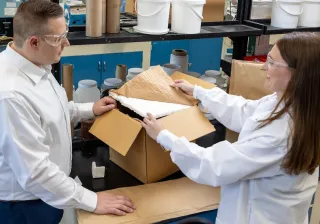New unique mobile application puts forest Big Data to more efficient use
The whole of Europe is feverishly looking for new ways to use farm, forest and fishery resources more responsibly and sustainably and to promote the production of the best possible raw materials in order to increase the availability of food, energy and biomaterials. VTT Technical Research Centre of Finland Ltd, the Finnish Forest Centre and MHG Systems Oy Ltd are among the organisations that have joined forces to accelerate European bioeconomy with the help of big data technologies based on aerial and satellite images and on open forest data provided by Finnish Forest Centre. The Finnish partners have developed, among other innovations, a unique mobile application that puts forest data to more efficient use.
"Population growth and urbanisation are increasing the demand for natural resources, which is putting a strain on the Earth's carrying capacity. The European DataBio (Data-driven Bioeconomy) project aims to develop new sustainable ways to use forest, farm and fishery resources and to communicate real-time information to decision-makers and producers – land- and forest owners, farmers and fishermen", explains Research Professor Caj Södergård from VTT, who acts as the project's Technology Manager.
The project has now resulted in the launch of 26 bioeconomy pilots in 17 different countries. The Finnish consortium is responsible for forestry pilots that are aimed at, among other things, making the collection and sharing of data easier across the value chain.
"One of the Finnish consortium's innovations is a globally unique concept based on forestry standards, which allows landowners and forestry operators to collect data on their forests using a smartphone and upload the data to the Finnish Forest Centre's forest resource database with the help of an application called Wuudis", explains Seppo Huurinainen from MHG Systems, who coordinates the DataBio project's forestry pilots.
"This facilitates the payment of sustainable forestry subsidies and makes it easier to collect information and keep forest inventories up to date, as the application accurately calculates the volume and quality of the trees left in a stand after care works and harvesting", Huurinainen adds.
Also scalable to other countries
The Wuudis service and the associated mobile application as well as standardized forest resource data concept provided by the Finnish Forest Centre can be easily scaled to other countries. The mobile application can be also used to monitor the effects of storms, snow, pests, diseases and the like. The solution developers are currently in talks with potential users in Spain and Africa, for example.
Another Finnish pilot has developed a service concept based on inventorying forests using drones. Thousands of hectares of forest have already been inventoried with the help of the service this summer.
All the pilots included in the project involve developing common software tools for analysing and refining information flows. The results of the pilots and the new solutions are also expected to create new business opportunities and increase the use of big data technologies in the bioeconomy industry's primary production.
"We are very excited, anticipating tangible success stories showing there is real value for all in using big data technologies in bioeconomy", says Dr Athanasios Poulakidas from Intrasoft International, who acts as the DataBio Project Coordinator.
The Finnish partners involved in the project are VTT, MHG Systems Ltd, the Finnish Forest Centre and Senop Oy. The project consortium also includes partners from Belgium, the Czech Republic, Germany, Spain, Norway, Poland, Italy, Greece, Israel, the Netherlands, Denmark, Switzerland, the United Kingdom, Estonia, France and Romania. The project, which is due to end in 2019, is co-financed by the EU's Horizon 2020 programme.
More about the project: https://www.databio.eu/




